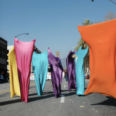Two Pasadena elementary schools have been identified by a new private study as being located in “dangerous elementary school zones” that experience disproportionately high numbers of traffic collisions involving vehicles, pedestrians and bicyclists.
San Diego based data visualization firm data firm 1Point21 Interactive released the study which names Pasadena’s own Madison Elementary and McKinley School as located in school zones that experienced frequent collisions within a half mile radius in 2015. The hefty project compiled over 400,000 collision records and compared California’s 6,000 plus elementary school locations in an effort to identify potentially dangerous routes for commuters.
Although the private study is not associated with the the City of Pasadena’s public safety efforts, the Department of Transportation says the findings are consistent with City data.
“Raising awareness is the number one goal because there is just no way the average parent would be able to do this on their own,” said 1Point21 Interactive Project Lead Brian Beltz about the study. “We want to make sure that parents of the kids at these schools are aware of the high volume of collisions around their school and can then hopefully make informed decisions about different and better ways to get to there.”
Last year the firm was commissioned by Los Angeles based personal injury firm Panish Shea & Boyle LLP to conduct the study in hopes of inspiring parents to take extra precautions when deciding how their kids will get to and from school.
The team queried and collected all 2015 collision records from the California Highway Patrol’s The Statewide Integrated Traffic Records System (SWITRS) database that holds more than 435,000 individual records.
“We took every single collision record from 2015 in California and cross referenced it with the location of every elementary school to find which accidents were within a half mile of a school and then identify the most dangerous school zones for kids to get to school,” explained Beltz.
The team then created a school zone’s risk score by giving a motor vehicle accident a 1 rating, pedestrian accidents a 3 and bicycle accidents a 2.
Madison Elementary and McKinley School’s final risk score was 29.60 and 28.20 respectively — nearly three times above the average school’s score of 8.69.
City officials had previously been aware of the high number of traffic incidents near Madison Elementary School.
“We already knew,” said Dept. of Transportation Traffic Engineering Manager Norman Baculinao.
Baculinao did not know that Madison Elementary is listed as being in a “dangerous school zone” as described and labeled by the new private 1point21Interactive study.
In 2010 and 2011, the City of Pasadena was ranked the highest and the 2nd highest for number of total annual fatal and injury crashes, respectively, among 53 cities with similar populations (i.e., within population group B of 100,001 – 250,000 people) in the State of California. The ranking was performed by the California Office of Traffic Safety. The City ranked within the top four during the same two years with respect to bicyclist and pedestrian injury crashes, according to a Pasadena Safer Streets Report.
To increase the effectiveness of enforcement, education, and engineering treatments aimed at reducing crashes, the City used the Safer Streets Pasadena project to enhance their existing Crossroads Traffic Collision Software by incorporating network screening performance measures from AASHTO’s Highway Safety Manual (HSM).
The HSM network screening performance measures help identify locations with the greatest potential for crash reduction.
“Our consultant developed a screening method to identify that top 5 locations that would require additional attention for potential safety improvements. The findings on the website seem to be consistent with our findings as the top three locations we identified on this project are located within a half-mile from these two elementary schools,” said Baculinao.
The City flagged the Madison Elementary School zone area on Los Robles between Orange Grove and Mountain for potential improvement in 2015, according to the Pasadena Safer Streets Report.
“We have implemented one of the elements already,” said Baculinao about the City’s recent installment of a new electronic speed sign on southbound Los Robles.
The Pasadena Unified School District was not aware of the 1point21Interactive study.
“Keeping students safe as they travel to and from school and while they’re on campus is a first priority for the Pasadena Unified School District. We take a comprehensive approach to traffic safety that includes assessments, training, community engagement and partnerships with local police, fire and the Department of Transportation officials,” said Pasadena Unified spokesperson Hilda Ramirez.
“The district conducts annual site assessments that include traffic, pedestrian and school safety,” Ramirez added. “If an issue or concern is raised by the principal or local community, we engage the Department of Transportation and they proceed with a traffic study that can result in placement of a crossing guard at a school.”
The City of Pasadena’s Safer Streets Pasadena – School Area Safety Program is part of Pasadena’s focus on pedestrian safety and includes classroom outreach to local third grade students, according to Ramirez.
The City received a $145,000 grant from the California Office of Traffic Safety (OTS) in August for use in its proposed Safer Streets – Pasadena School Area Safety Program for 2017 through 2017.
The program supports the city’s General Plan guiding principle that Pasadena will be a city where people can circulate without cars.
“PUSD’s safety team interacts regularly with the Pasadena Police Department and City traffic safety officials to create safer drop off and pickup zones around schools. To minimize risks to children during morning drop off and afternoon pick up, PUSD schools stagger start times,” said Ramirez.
According to a program description, Safer Streets will combine education and outreach objectives, using a classroom-level pedestrian outreach campaign to third grade students while also addressing parents and motorists who drive through school zones in the Pasadena area.
As part of the program, the city will also update suggested routes to school maps for each of the 18 elementary and middle schools in Pasadena and survey students to determine what routes they take to school and what factors contribute to their decision whether or not to walk to school.
“Schools communicate with parents, faculty, staff and students in the beginning of the school year about current traffic patterns and traffic concerns and deliver updates throughout the year. Parents are reminded to give themselves plenty of time to get children to school safely and to observe traffic safety laws around schools. At regular school assemblies, students are reminded about pedestrian and traffic safety,” explained Ramirez.
Activities within the program also include the expansion of the “We Make Time” pedestrian safety campaign developed by the city in 2014.
The ‘Dangerous School Zone’ study is a clear indicator that the efforts of Pasadena already being implemented to create a safer city are on the right track, a city official said.
“It’s good confirmation about what we did last year,” said Baculinao about the Pasadena Safer Streets Project improvements on Los Robles.














 0 comments
0 comments



